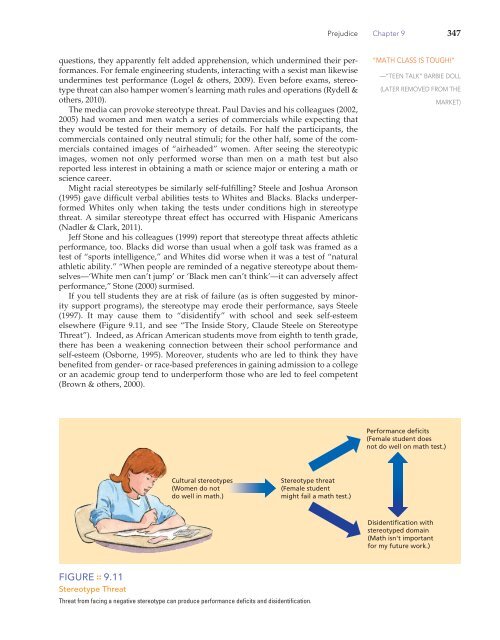Chapter 9: Prejudice: Disliking Others (2947.0K) - Bad Request
Chapter 9: Prejudice: Disliking Others (2947.0K) - Bad Request
Chapter 9: Prejudice: Disliking Others (2947.0K) - Bad Request
Create successful ePaper yourself
Turn your PDF publications into a flip-book with our unique Google optimized e-Paper software.
questions, they apparently felt added apprehension, which undermined their performances.<br />
For female engineering students, interacting with a sexist man likewise<br />
undermines test performance (Logel & others, 2009). Even before exams, stereotype<br />
threat can also hamper women’s learning math rules and operations (Rydell &<br />
others, 2010).<br />
The media can provoke stereotype threat. Paul Davies and his colleagues (2002,<br />
2005) had women and men watch a series of commercials while expecting that<br />
they would be tested for their memory of details. For half the participants, the<br />
commercials contained only neutral stimuli; for the other half, some of the commercials<br />
contained images of “airheaded” women. After seeing the stereotypic<br />
images, women not only performed worse than men on a math test but also<br />
reported less interest in obtaining a math or science major or entering a math or<br />
science career.<br />
Might racial stereotypes be similarly self-fulfilling? Steele and Joshua Aronson<br />
(1995) gave difficult verbal abilities tests to Whites and Blacks. Blacks underperformed<br />
Whites only when taking the tests under conditions high in stereotype<br />
threat. A similar stereotype threat effect has occurred with Hispanic Americans<br />
(Nadler & Clark, 2011).<br />
Jeff Stone and his colleagues (1999) report that stereotype threat affects athletic<br />
performance, too. Blacks did worse than usual when a golf task was framed as a<br />
test of “sports intelligence,” and Whites did worse when it was a test of “natural<br />
athletic ability.” “When people are reminded of a negative stereotype about themselves—‘White<br />
men can’t jump’ or ‘Black men can’t think’—it can adversely affect<br />
performance,” Stone (2000) surmised.<br />
If you tell students they are at risk of failure (as is often suggested by minority<br />
support programs), the stereotype may erode their performance, says Steele<br />
(1997). It may cause them to “disidentify” with school and seek self-esteem<br />
elsewhere ( Figure 9.11 , and see “The Inside Story, Claude Steele on Stereotype<br />
Threat”). Indeed, as African American students move from eighth to tenth grade,<br />
there has been a weakening connection between their school performance and<br />
self-esteem (Osborne, 1995). Moreover, students who are led to think they have<br />
benefited from gender- or race-based preferences in gaining admission to a college<br />
or an academic group tend to underperform those who are led to feel competent<br />
(Brown & others, 2000).<br />
FIGURE :: 9.11<br />
Stereotype Threat<br />
Cultural stereotypes<br />
(Women do not<br />
do well in math.)<br />
Threat from facing a negative stereotype can produce performance deficits and disidentification.<br />
Stereotype threat<br />
(Female student<br />
might fail a math test.)<br />
<strong>Prejudice</strong> <strong>Chapter</strong> 9 347<br />
“MATH CLASS IS TOUGH!”<br />
—“TEEN TALK” BARBIE DOLL<br />
(LATER REMOVED FROM THE<br />
Performance deficits<br />
(Female student does<br />
not do well on math test.)<br />
Disidentification with<br />
stereotyped domain<br />
(Math isn't important<br />
for my future work.)<br />
MARKET)

















